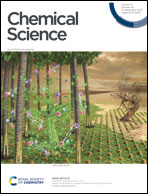Boroles from alumoles: accessing boroles with alkyl-substituted backbones via transtrielation†
Abstract
The alumole Cp3tAlC4Et4 (Cp3t = 1,2,4-tris(tert-butyl)cyclopentadienyl) is reported to be capable of transferring its butadiene moiety to aryl(dihalo)boranes to generate boroles through aluminum–boron exchange. The products feature a rare alkyl-substituted backbone, which, as shown in other examples, often leads to dimerization due to insufficient steric protection of the antiaromatic borole ring. Sterically crowded aryl groups bound to the boron atom are shown to prevent dimerization, allowing access to the first monomeric derivatives of this type. Results from UV-vis spectroscopy, electrochemistry, and DFT calculations reveal that the alkyl substituents cause remarkable modifications in the optical and electronic properties of the boroles compared to their perarylated counterparts.

- This article is part of the themed collections: 2023 Chemical Science HOT Article Collection, #MyFirstChemSci 2023 and 2023 ChemSci Pick of the Week Collection


 Please wait while we load your content...
Please wait while we load your content...